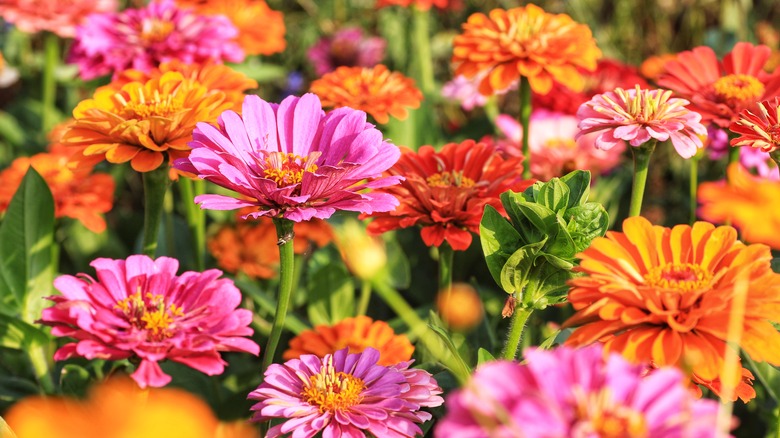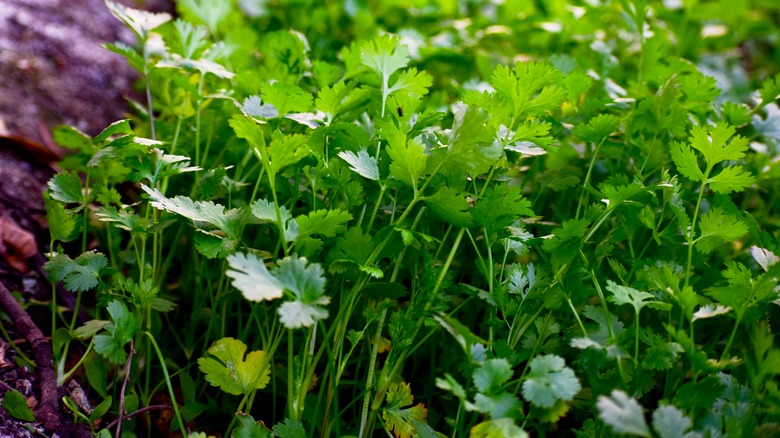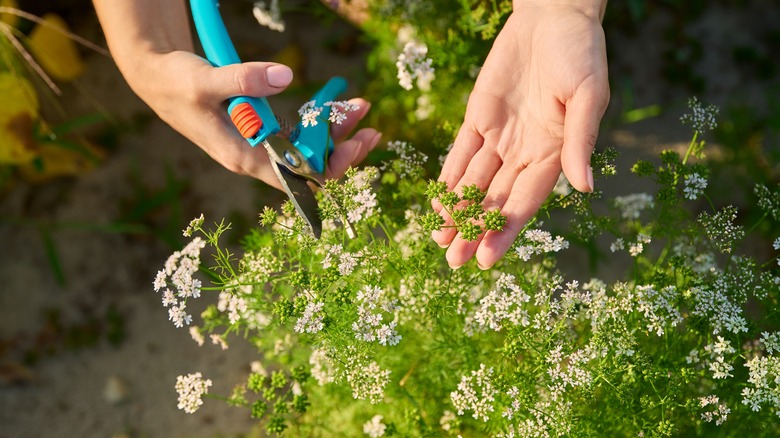The Delicious Garden Herb That Thrives Next To Colorful Zinnias
What's better than a patch of zinnias in your garden? Perhaps it's a multipurpose flower bed that has zinnia-friendly herbs. Finding a companion for zinnias can be a challenge since they need all the sunlight they can get and prefer soil on the dry side. Pairing it with cilantro works well because while cilantro does enjoy full sun, it needs shade in the summer, so you can prevent it from bolting so soon. Since cilantro is a cool-season plant and zinnias grow in summer, you can use their offset schedules to your advantage to make the most of your garden space.
Between cilantro and zinnias, you'll have a garden full of pollinators. They love the flowers cilantro grows once they start bolting. If they bolt before your zinnias grow flowers, you can get a head start on pollinators this way. These two plants don't seem like they'd make good garden neighbors, but they have the right amount of give and take between each other to make it work.
Cilantro and zinnia growing schedules complement each other
You may be surprised that cilantro is a cool-season herb since it's used in summery condiments like guacamole, salsa, and salad dressing. It's true; those parsley-like green leaves you use to flavor rice and curry are best when planted and harvested in the spring and fall. Hot temperatures will cause cilantro to bolt. When this happens, it develops flower stalks that will eventually hold seeds, a spice called coriander. If you love coriander seeds, allow your cilantro to bolt. Otherwise, use zinnias to your advantage.
Zinnias are warm-season flowers that need to be planted outdoors once the danger of frost has passed. By the time you're ready to plant zinnia seeds, you'll have been harvesting cilantro for at least a few weeks. You can plant zinnias around cilantro, leaving up to 2 feet between the plants, depending on the type of zinnias you have. Cilantro grows 1 foot tall, and zinnias can reach up to 4 feet. By the time zinnias are tall enough to cast shade, the cilantro will need the shade to keep cool.
Zinnias will grow into the fall, and this is when you can start planting cilantro again. Plant cilantro seeds or transplants while zinnias are still tall and blooming. This will keep the tender seeds and seedlings cool while the lingering summer heat cools down. The temperatures should be cilantro-friendly by the time dead zinnias are ready to be pulled.
Cilantro needs what zinnias don't
Cilantro likes moist soil, while zinnias are drought-tolerant. Zinnias benefit from moist soil, but too much moisture will cause fungal diseases like powdery mildew, so it's better to keep it dry. It may seem like keeping these two plants happy together will be difficult, but it actually works out quite well. Plant cilantro on one side and zinnias on the other, and when it's time to water, water at the base of the cilantro and let the water run off towards the zinnias. Cilantro will soak up extra water since they're thirstier plants. Watering at the soil level is the best way to prevent zinnia leaves from developing fungal diseases.
Zinnias cast shade on surrounding short plants, but cilantro won't mind if the temperatures are hot. Cilantro tends to bolt as warm spring weather transitions to hot summer weather, and it struggles to germinate if temperatures are too hot, making fall planting difficult in warm climates (cilantro germinates best when temperatures are 55-68 degrees Fahrenheit). When planning your garden bed, plan on planting zinnias on the south side and cilantro on the north. Zinnias will receive more sunlight facing south while casting shade on cilantro.


